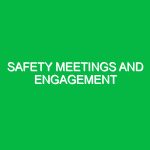In the ever-evolving landscape of workplace safety, the concept of Continuous improvement in safety has gained paramount importance. As industries face increasing scrutiny regarding health and safety protocols, a proactive approach not only enhances compliance but also fosters a culture of safety that protects employees and the environment. This article delves into the intricacies of continuous improvement in safety within the Health, Safety, and Environment (HSE) domain, exploring its significance, potential hazards, best practices, and relevant regulations.
Understanding Continuous Improvement in Safety
Continuous improvement in safety refers to an ongoing effort to enhance safety practices, protocols, and culture within an organization. It involves systematically identifying opportunities for improvement, implementing changes, and evaluating the effectiveness of those changes. In the HSE domain, this encompasses not only compliance with existing regulations but also embracing a mindset that prioritizes risk management and employee well-being.
This concept is deeply rooted in methodologies such as Plan-Do-Check-Act (PDCA) and Lean principles, which advocate for iterative processes that drive efficiency and quality in safety practices. By fostering an environment where feedback is valued and encouraged, organizations can adapt to emerging challenges and continuously evolve their safety standards.
Identifying Potential Hazards and Risks
When discussing continuous improvement in safety, it is crucial to identify the potential hazards that can arise in various work environments. These hazards can be broadly categorized into several types:
1. Physical Hazards
Physical hazards refer to environmental factors that can cause harm. This includes slips, trips, and falls, which are among the most common workplace incidents. For example, in a manufacturing facility, wet floors or cluttered walkways can lead to serious injuries. Recognizing these risks is the first step toward developing effective safety measures.
2. Chemical Hazards
Exposure to harmful substances can result in acute or chronic health conditions. Industries such as construction and manufacturing often deal with hazardous chemicals. For instance, improper handling of solvents can lead to respiratory issues. Continuous improvement means regularly reviewing the handling protocols of these substances and ensuring that safety data sheets (SDS) are accessible and up-to-date.
3. Biological Hazards
In workplaces where exposure to biological agents is possible, continuous improvement efforts must address potential risks. Healthcare facilities, for instance, must protect workers from pathogens. Implementing stringent hygiene practices and providing proper training on infection control are essential steps in mitigating these risks.
4. Ergonomic Hazards
Ergonomic hazards arise when a worker’s physical capabilities do not match their tasks. This could lead to musculoskeletal disorders (MSDs), which are prevalent in labor-intensive jobs. Continuous improvement involves regularly assessing workstations, encouraging proper posture, and investing in ergonomic equipment.
Best Practices for Continuous Improvement in Safety
Implementing a culture of continuous improvement in safety requires a structured approach. Here are some best practices to consider:
1. Employee Involvement
Engaging employees at all levels is vital. They often have firsthand knowledge of potential hazards and can provide valuable insights. Regular safety meetings and suggestion boxes can encourage open dialogue. For instance, in a construction firm, workers might notice that certain equipment consistently malfunctions. Addressing these concerns not only improves safety but also boosts morale.
2. Regular Training and Awareness Programs
Training should not be a one-time event. Continuous improvement means providing regular training sessions and refresher courses. This ensures that employees remain aware of safety protocols and any changes in regulations. Interactive training sessions, including simulations and drills, can enhance retention and preparedness.
3. Data-Driven Decision Making
Utilizing data to monitor safety performance is essential. Track incident reports, near-misses, and safety audits to identify patterns and areas needing improvement. For example, if data reveals a spike in slips during rainy weather, additional safety measures, such as mats or signage, can be implemented.
4. Implementing Technology
Technological advancements can significantly enhance safety protocols. Wearable technology, such as safety vests equipped with sensors, can monitor environmental conditions and alert workers to hazards. Furthermore, software solutions that track compliance and provide analytics can streamline the continuous improvement process.
5. Regular Audits and Assessments
Conducting regular safety audits helps identify gaps in compliance and opportunities for improvement. For example, an audit might reveal that emergency exits are blocked, prompting immediate corrective action. These assessments should be systematic and involve both management and employees.
Safety Precautions for Identified Hazards
Once hazards are identified, implementing safety precautions is critical. Here are some actionable strategies:
1. Physical Safety Measures
To mitigate physical hazards, organizations should ensure that walkways are well-maintained and free of obstructions. Regular inspections and maintenance schedules can help identify potential problems before they lead to incidents. Additionally, implementing slip-resistant flooring in high-traffic areas can significantly reduce accidents.
2. Chemical Handling Procedures
For chemical hazards, establishing strict protocols for the storage, handling, and disposal of hazardous materials is crucial. Regular training on the use of personal protective equipment (PPE) and emergency response plans can prevent exposure and minimize risks.
3. Hygiene and Safety in Biological Contexts
In environments with biological hazards, instituting rigorous cleaning protocols and ensuring access to handwashing stations can help maintain safety. Regular training on the importance of hygiene and the use of PPE can further safeguard employees’ health.
4. Ergonomic Assessments
To address ergonomic hazards, organizations should conduct assessments to identify high-risk tasks. Implementing job rotation, providing adjustable workstations, and encouraging regular breaks can reduce the risk of MSDs.
Relevant Regulations and Standards
Understanding the regulatory landscape is essential for continuous improvement in safety. Various standards govern safety practices across industries. Here are some key regulations:
1. Occupational Safety and Health Administration (OSHA)
In the United States, OSHA sets and enforces standards for workplace safety. Organizations must comply with OSHA regulations to ensure a safe working environment. Regular training and adherence to OSHA guidelines are foundational to continuous improvement efforts.
2. International Organization for Standardization (ISO) Standards
ISO 45001 is a global standard for occupational health and safety management systems. It provides a framework for organizations to enhance safety performance and manage risks effectively. Adopting ISO standards can significantly contribute to continuous improvement in safety.
3. National Institute for Occupational Safety and Health (NIOSH)
NIOSH conducts research and makes recommendations to prevent work-related injury and illness. Their guidelines and recommendations can provide valuable resources for organizations seeking to improve their safety protocols.
Conclusion
Continuous improvement in safety is not merely a regulatory requirement; it is a fundamental aspect of creating a thriving workplace. By adopting a proactive approach to safety, organizations can protect their most valuable asset—their employees. Through regular training, employee engagement, data-driven decision-making, and adherence to regulations, continuous improvement can foster a culture of safety that benefits everyone involved.
The journey toward enhanced safety is ongoing, and each step taken contributes to a safer future. As industries evolve and new challenges arise, the commitment to continuous improvement in safety will be the cornerstone of successful health, safety, and environmental management.


